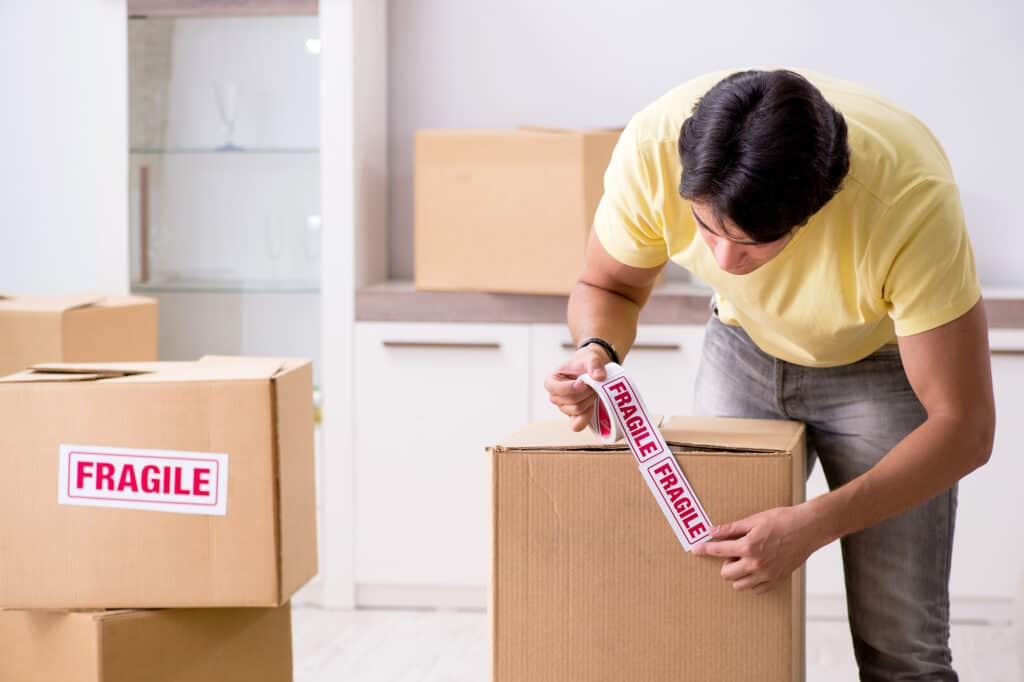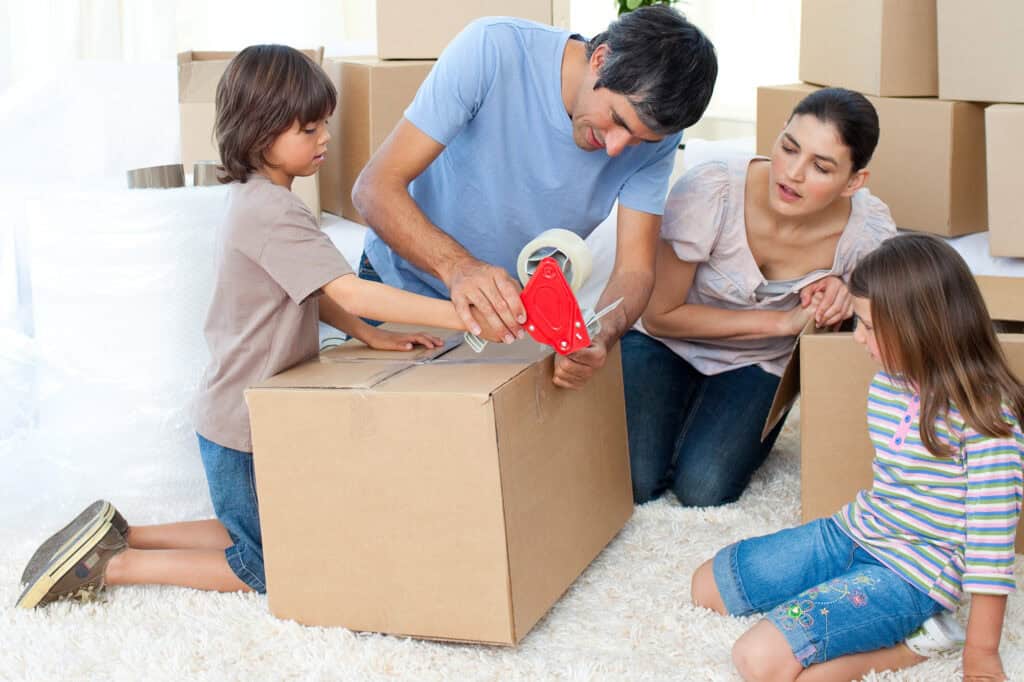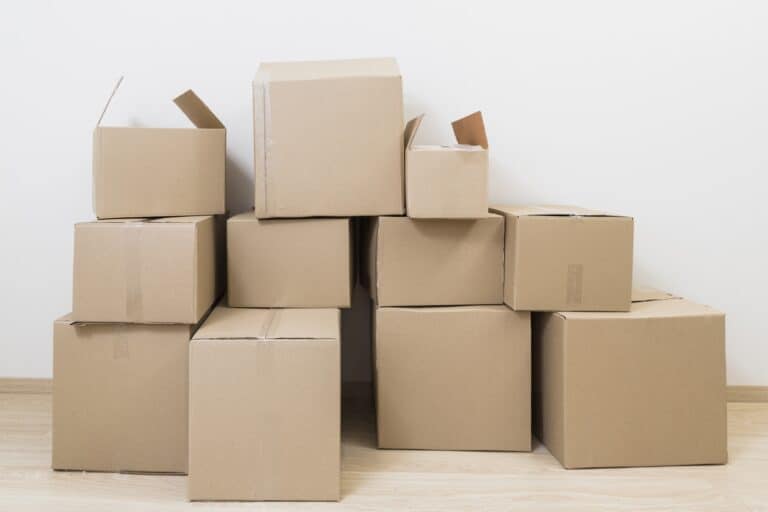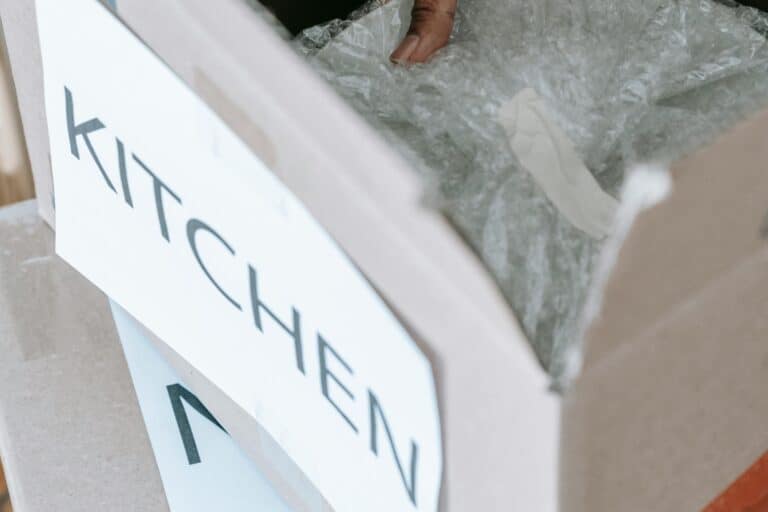Knowing how to pack household items safely for a move is essential to prevent damage and stress. This guide covers the best practices for packing various items securely, from fragile glassware to large furniture. Follow these tips to ensure a smooth and safe move.
Key Takeaways
- Gather essential packing supplies early, and consider budget-friendly options like free boxes from community sources.
- Use appropriate boxes and cushioning materials, like bubble wrap or packing paper, especially for fragile items.
- Create an organised labelling and inventory system to streamline unpacking, and don’t forget to prepare an essentials box for your first day in the new home.
Essential Packing Supplies for a Safe Move
The foundation of a successful move lies in having the right packing supplies. From cardboard boxes to bubble wrap, each item plays a crucial role in ensuring your belongings are protected during transit.
Gather all necessary packing materials early to begin packing and streamline the process and avoid last-minute scrambles.
Gathering Packing Materials
Finding packing materials doesn’t have to break the bank. Look for free or low-cost options on platforms like Gumtree and Facebook Marketplace, or even check with your local library.
Store cardboard boxes in a dry, well-ventilated space to keep them intact. You can donate, recycle, or sell your packing materials after the move.
Choosing the Right Boxes
Use large boxes for light items like linens and pillows to maximise space. For heavier items, opt for smaller boxes to make lifting easier and prevent breakage.
Check the sturdiness of your boxes to make sure they can handle the weight and protect your belongings during the move.
Using Bubble Wrap and Packing Paper
Bubble wrap and packing paper are your best friends when it comes to protecting fragile items. Wrap each item individually and use plenty of packing paper to fill any gaps in the boxes. This cushioning will prevent items from shifting during transit and reduce the risk of damage.
NOTE
If you run out of bubble wrap, towels and blankets can also provide excellent padding.
Smart Strategies for Packing Fragile Items
Packing fragile items requires extra care and attention. Using the right materials, including packing tape, and techniques ensures your delicate belongings arrive safely at your new home.
Here are some smart strategies to keep in mind.
Wrapping Delicate Items
Wrap plates and glassware in packing material to prevent scratches and absorb shocks. Use packing paper between items to add an extra layer of protection.
For hollow items, fill them with packing material to prevent vibrations that could cause damage.
Labelling Boxes with Fragile Items
Clearly label boxes containing fragile items and note their contents for safe handling. This ensures that movers know to handle these boxes with extra care and helps you locate items quickly during unpacking.
Using Egg Cartons and Toilet Paper Rolls
Innovative packing solutions can make a big difference. Use egg cartons to secure small, delicate items like jewellery. Thread necklaces through toilet paper rolls to prevent tangling.
These everyday household items can provide excellent protection for your valuables.
Efficient Room-by-Room Packing Tips
Packing room by room keeps the process organised and manageable. Begin with rooms you use least, like the basement or attic, and move to more frequently used spaces.
Here are some specific tips for different rooms in your house.
Kitchen Packing Techniques
Packing the kitchen can be tricky due to the variety of items. Wrap each dish in packing paper, bundle them together, and pack them on their sides in dish-barrel boxes. Use dividers for glasses and wrap them in multiple layers of paper.
Pack appliances like the refrigerator and microwave separately, and fill any empty spaces with packing materials for added protection.
Living Room Packing Advice
The living room often contains bulky furniture and electronics. Disassemble what you can and use furniture covers to prevent scratches. Pack smaller items, like books and decorations, in sturdy boxes, and label them clearly.
Ensure that heavy boxes are placed at the bottom to create a stable load.
Bedroom Packing Essentials
Use wardrobe boxes to keep hanging clothes wrinkle-free. Pack clothes in suitcases or leave them in dressers for convenience. Use vacuum or plastic bags for bedding to keep it clean during the move.
An essentials box with items like pyjamas and toiletries can make your first night in your new home more comfortable.
Special Considerations for Large and Bulky Items
Large and bulky items require special attention.
Here’s how to handle these challenging items to ensure they arrive safely at your new home.
Disassembling Furniture
Disassembling furniture saves space in the moving truck and makes pieces easier to handle. Take photos of each stage of disassembly to help with reassembly later.
Keep all screws and small parts in labelled bags attached to the main piece to avoid losing them.
Using Furniture Covers
Furniture covers prevent scratches and dents. Use old blankets or rent covers from a local moving company. Professional movers often provide specific blankets and tape for wrapping furniture, ensuring it stays protected during the move.
Packing Outdoor Furniture
Before packing outdoor furniture, clean it thoroughly to remove any dirt and pests. Disassemble what you can and use heavy-duty boxes and packing materials for protection.
Wrap cushions in plastic to prevent moisture damage and store them in labelled boxes.
Organizing and Labelling for an Easy Unpack

Labelling and organising are key to a smooth unpacking process. Creating a checklist and a well-structured system can save you time and stress when you arrive at your new home.
Creating a Labelling System
Label each box with its room and a brief description of its contents. Use different colours for labels corresponding to each room for easier identification.
Remember to label parts of dismantled furniture and keep screws in labelled bags.
Keeping an Inventory List
An inventory list helps track your belongings and ensures nothing is left behind. Include descriptions, serial numbers, and photos for valuable items.
Update the list regularly and use it to check items during loading and unloading to ensure everything is accounted for.
Preparing an Essentials Box
An essentials box is crucial for the first 24 hours in your new home. Include items like toiletries, a change of clothes, and basic kitchen supplies. Keep this box in your own vehicle to ensure it’s easily accessible.
Using a clear plastic box can help you identify its contents quickly.
Handling Hazardous Materials Safely
Handling hazardous materials requires careful attention to safety. Here are some tips to manage them properly during your move.
Identifying Hazardous Materials
Identify hazardous materials like batteries, paints, and certain cleaning products. These items require special handling and should not be disposed of in regular trash.
Check with local authorities for designated disposal services.
Safe Packing Methods
Pack hazardous materials securely using original containers and seal them tightly. Label these items clearly and follow local regulations for transport or disposal.
Be aware of items that cannot be moved and plan for their safe disposal.
Disposal of Non-Transportable Items
Some hazardous materials cannot be transported and must be disposed of before the move. Common items include paint, cleaning supplies, and pesticides. Contact your local waste management facility for guidelines on proper disposal methods. Always use original containers, seal them tightly, and label them appropriately to ensure safe packing and disposal.
Hiring Professional Packing Services
Hiring professional packing services can save time and reduce stress, allowing you to focus on other aspects of the move.
Full Packing Service
A full packing service covers everything from packing delicate items to large furniture. They supply all necessary packing materials and ensure your belongings are packed securely.
Handling the entire packing process allows you to focus on other important tasks.
Part-Packing Options
Part-packing services offer flexibility, letting you decide which items you want professionally packed while you handle the rest. This option is cost-effective and ensures that your most valuable and delicate items are packed with care.
It’s a great way to balance professional help with personal involvement in the moving process.
Specialised Packing for Valuables
Specialised packing services are ideal for valuable items like artwork and antiques. Professionals use custom crating and bubble wrap to protect these items during the move.
This ensures that your most precious belongings arrive at your new home in perfect condition during moving house.
Summary
Packing for a move doesn’t have to be stressful. By gathering the right packing supplies, using smart strategies for fragile items, and organising effectively, you can ensure a smooth and safe transition to your new home. Whether you handle the packing yourself or hire professionals, these tips will help protect your belongings and make unpacking a breeze. Happy moving!
Frequently Asked Questions
What are the essential packing supplies I need for a move?
You’ll definitely want to stock up on cardboard boxes, bubble wrap, packing tape, packing paper, and markers to make your move smooth. These essentials will help protect your items and keep everything organised.
How should I pack fragile items to prevent damage?
To prevent damage, wrap each fragile item individually with bubble wrap or packing paper, use packing material to fill any gaps, and clearly label the box as fragile. This will help ensure your items arrive safely!
What should I include in an essentials box?
Definitely include toiletries, a change of clothes, basic kitchen supplies, and a first aid kit to cover your needs in the first 24 hours. This way, you’ll have everything crucial right at your fingertips!
How can I safely pack hazardous materials?
To safely pack hazardous materials, always use the original containers, seal them tightly, and make sure to label everything properly. Don’t forget to follow local regulations and check with authorities for safe disposal options.
What are the benefits of hiring professional packing services?
Hiring professional packing services saves you time and stress while ensuring your belongings are securely packed. It’s a smart choice for a smooth move and peace of mind.







